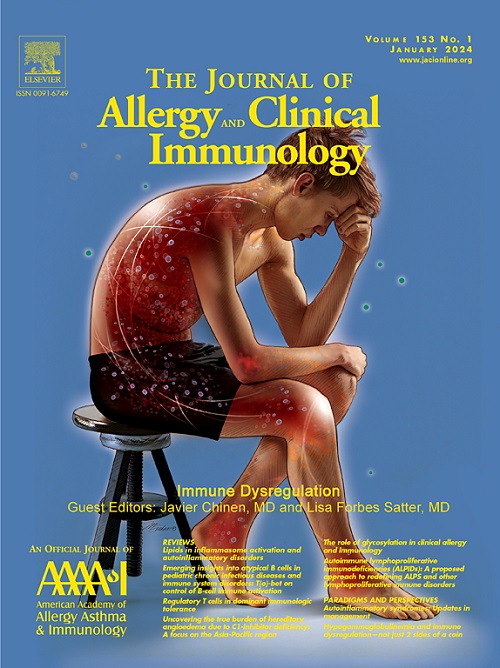白癜风患者的转录组学分析显示受累和未受累皮肤的极性免疫失调。
IF 11.2
1区 医学
Q1 ALLERGY
引用次数: 0
摘要
背景:白癜风是一种慢性自身免疫性皮肤脱色障碍,对生活质量有重大影响。治疗选择仍然有限,只有一种局部JAK抑制剂被fda批准。虽然白癜风主要被认为是一种由Th1/ ifn驱动的疾病,但新出现的证据表明,其他免疫轴也参与其中,但它们与疾病发病机制的相关性尚不清楚。目的:获得病变性和非病变性白癜风的全球皮肤转录组学特征。方法:我们对15例病变性和非病变性白癜风样本的皮肤活检进行了大量rna测序、实时PCR和免疫组化,并将其与14例匹配的健康对照进行了比较。结果被单细胞RNA测序证实。结果:与健康对照相比,不仅在病变性白癜风皮肤中,而且在非病变性白癜风皮肤中也捕获了强烈的炎症失调。病变样本显示Th1 (OASL、CXCL9、CXCL10)、Th2 (IL4、IL4R、CCL13、CCL17、CCL22、CCL26)和Th17/22 (IL20、S100A7、S100A8、S100A9、PI3)相关标记上调。同样,非病变样品显示Th1 (CXCL9, OASL), Th2 (IL4R, IL10, CCL13, CCL17, CCL22)和Th17/22 (PI3, DEFB4A)相关标记的激活。病变性和/或非病变性白癜风皮肤的临床严重程度评分(VASI和/或VIDA)与多种炎症介质(即CXCL14、IL25、IL17RC)显著正相关。在单细胞水平上,IL13和IFNG的表达主要分别存在于非病变性辅助性T细胞和病变性增殖性T细胞中。结论:我们的研究结果表明,白癜风的免疫失调涉及Th1/Tc1以外的免疫轴,特别是非病变皮肤中2型标记物的上调,表明在早期病变形成过程中起作用。本文章由计算机程序翻译,如有差异,请以英文原文为准。
Transcriptomic profiling of vitiligo patients shows polar immune dysregulation in involved and uninvolved skin
Background
Vitiligo is a chronic autoimmune skin depigmenting disorder, with a major impact on quality of life. Therapeutic options are still limited, with only one topical JAK inhibitor being approved by the US Food and Drug Administration. Although vitiligo is primarily regarded as a TH1/interferon-driven disease, emerging evidence suggests the involvement of additional immune axes, but their relevance to disease pathogenesis remains unclear.
Objective
We sought to obtain a global cutaneous transcriptomic profile of lesional and nonlesional vitiligo.
Methods
We performed bulk RNA sequencing combined with real-time PCR and immunohistochemistry of skin biopsy samples from 15 lesional and nonlesional vitiligo samples and compared them to 14 matched healthy controls. Results were corroborated by single-cell RNA sequencing.
Results
Robust inflammatory dysregulation was captured not only in lesional but also nonlesional vitiligo skin relative to healthy controls. Lesional samples demonstrated upregulation of TH1 (OASL, CXCL9, CXCL10), TH2 (IL4, IL4R, CCL13, CCL17, CCL22, CCL26), and TH17/22 (IL20, S100A7, S100A8, S100A9, PI3) related markers. Similarly, nonlesional samples demonstrated activation of TH1 (CXCL9, OASL), TH2 (IL4R, IL10, CCL13, CCL17, CCL22), and TH17/22 (PI3, DEFB4A) associated markers. Clinical severity scores (Vitiligo Area Scoring Index and/or Vitiligo Disease Activity Index) significantly and positively correlated with multiple inflammatory mediators (ie, CXCL14, IL25, IL17RC) in lesional and/or nonlesional vitiligo skin. On a single-cell level, IL13 and IFNG expression were primarily found in nonlesional helper T cells and in lesional proliferating T cells, respectively.
Conclusions
Our findings show that immune dysregulation in vitiligo involves immune axes beyond TH1/Tc1, with particular upregulation of type 2 markers already observed in nonlesional skin, suggesting a role during early lesion formation.
求助全文
通过发布文献求助,成功后即可免费获取论文全文。
去求助
来源期刊
CiteScore
25.90
自引率
7.70%
发文量
1302
审稿时长
38 days
期刊介绍:
The Journal of Allergy and Clinical Immunology is a prestigious publication that features groundbreaking research in the fields of Allergy, Asthma, and Immunology. This influential journal publishes high-impact research papers that explore various topics, including asthma, food allergy, allergic rhinitis, atopic dermatitis, primary immune deficiencies, occupational and environmental allergy, and other allergic and immunologic diseases. The articles not only report on clinical trials and mechanistic studies but also provide insights into novel therapies, underlying mechanisms, and important discoveries that contribute to our understanding of these diseases. By sharing this valuable information, the journal aims to enhance the diagnosis and management of patients in the future.

 求助内容:
求助内容: 应助结果提醒方式:
应助结果提醒方式:


